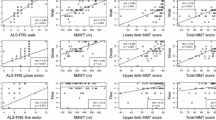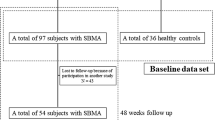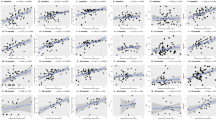Abstract
Background
Spinal and bulbar muscular atrophy (SBMA) is a late onset, X-linked neuromuscular disease. Bulbar symptoms are a main characteristic of the disease but a tool for their clinical evaluation still does not exist. The aim of this study was to design and test a new scale (6-K-scale) for evaluation of bulbar function in SBMA.
Methods
We considered 60 genetically confirmed SBMA patients and built a scale to evaluate the V, VII, IX, X, and XII cranial nerves (CN) and the ansa cervicalis. Functional status was evaluated through the Spinal and Bulbar Muscular Atrophy Functional Rating Scale (SBMAFRS), 6-min-walk-test (6MWT), Adult Myopathy Assessment Tool (AMAT) scale, and FVC%. Twenty patients underwent a re-test after 3 weeks, while 31 were tested longitudinally after 6 months. Validation of the scale included reliability assessment and factorial analysis. To evaluate convergent validity, correlations between the 6-K-scale and functional parameters were performed.
Results
Internal consistency as measured by Cronbach’s alpha was high (0.85) as was test–retest reliability. Principal component analysis yielded a six-factor solution accounting for 71.7% of the variance. The scale score was strongly correlated with the functional parameters.
Conclusion
In conclusion, we designed and validated a new scale for bulbar evaluation in SBMA patients. This scale will be a useful tool in the clinical practice as well as a possible outcome measure in clinical trials.
Similar content being viewed by others
References
Fischbeck KH (1997) Kennedy disease. J Inherit Metab Dis 20(2):152–158
Manzano R, Sorarù G, Grunseich C et al (2018) Beyond motor neurons: expanding the clinical spectrum in Kennedy’s disease. J Neurol Neurosurg Psychiatry 89:808–812. https://doi.org/10.1136/jnnp-2017-316961
Fratta P, Nirmalananthan N, Masset L, Skorupinska I, Collins T, Cortese A, Pemble S, Malaspina A, Fisher EMC, Greensmith L, Hanna MG (2014) Correlation of clinical and molecular features in spinal bulbar muscular atrophy. Neurology 82(23):2077–2084. https://doi.org/10.1212/WNL.0000000000000507
Chahin N, Klein C, Mandrekar J, Sorenson E (2008) Natural history of spinal-bulbar muscular atrophy. Neurology 70(21):1967–1971. https://doi.org/10.1212/01.wnl.0000312510.49768.eb
Bertolin C, Querin G, Da Re E et al (2016) No effect of AR polyG polymorphism on spinal and bulbar muscular atrophy phenotype. Eur J Neurol 23(6):1134–1136. https://doi.org/10.1111/ene.13001
Atsuta N, Watanabe H, Ito M et al (2006) Natural history of spinal and bulbar muscular atrophy (SBMA): a study of 223 Japanese patients. Brain 129:1446–1455
Finsterer J, Sorarù G (2016) Onset manifestations of spinal and bulbar muscular atrophy (Kennedy's disease). J Mol Neurosci 58(3):321–329. https://doi.org/10.1007/s12031-015-0663-x
Hashizume A, Katsuno M, Banno H, Suzuki K, Suga N, Mano T, Atsuta N, Oe H, Watanabe H, Tanaka F, Sobue G (2012) Longitudinal changes of outcome measures in spinal and bulbar muscular atrophy. Brain 135:2838–2848
Warnecke T, Oelengerg S, Terisman I et al (2009) Dysphagia in X-linked bulbospinal muscular atrophy (Kennedy disease). Neuromuscul Disord 19(10):704–708. https://doi.org/10.1016/j.nmd.2009.06.371
Tanaka S, Banno H, Katsuno M, Suzuki K, Suga N, Hashizume A, Mano T, Araki A, Watanabe H, Adachi H, Tatsumi H, Yamamoto M, Sobue G (2014) Distinct acoustic features in spinal and bulbar muscular atrophy patients with laryngospasm. J Neurol Sci; 15 337(1–2):193–200. https://doi.org/10.1016/j.jns.2013.12.010
Morimoto N, Yamashita T, Sato K, Kurata T, Ikeda Y, Kusuhara T, Murata N, Abe K (2013) Assessment of swallowing in motor neuron disease and Asidan/SCA36 patients with new methods. J Neurol Sci 324(1–2):149–155. https://doi.org/10.1016/j.jns.2012.10.025
Rangarathnam B, McCollough G (2016) Utility of a clinical swallowing exam for understanding swallowing physiology. Dysphagia 31:491–497. https://doi.org/10.1007/s00455-016-9702-1
Koch I, Ferrazzi A, Busatto C, Ventura L, Palmer K, Stritoni P, Meneghello F, Battel I (2017) Cranial nerve examination for neurogenic dysphagia patients. Otolaryngol (Sunnyvale) 7:4. https://doi.org/10.4172/2161-119X.1000319
Hashizume A, Katsuno M, Suzuki K, Banno H, Suga N, Mano T, Araki A, Hijikata Y, Grunseich C, Kokkinis A, Hirakawa A, Watanabe H, Yamamoto M, Fischbeck KH, Sobue G (2015) A functional scale for spinal and bulbar muscular atrophy: cross-sectional and longitudinal study. Neuromuscul Disord 25(7):554–562. https://doi.org/10.1016/j.nmd.2015.03.008
Querin G, Da Re E, Martinelli I et al (2016) Validation of the Italian version of the SBMA functional rating scale as outcome measure. Neurol Sci 37(11):1815–1821
Weydt P, Sagnelli A, Rosenbohm A, Fratta P, Pradat PF, Ludolph AC, Pareyson D (2016) Clinical trials in spinal and bulbar muscular atrophy – past, present and future. J Mol Neurosci 58(3):379–387. https://doi.org/10.1007/s12031-015-0682-7
Harri-Love MO, Fernandez-Rhodes L, Joe G et al (2014) Assessing function and endurance in adults with spinal and bulbar muscular atrophy: validity of the adult myopathy assessment tool. Rehabil Res Pract 2014:873872. https://doi.org/10.1155/2014/873872
Mano T, Katsuno M, Banno H, Suzuki K, Suga N, Hashizume A, Araki A, Watanabe H, Tanaka S, Yamamoto M, Sobue G (2014) Tongue pressure as a novel biomarker of spinal and bulbar muscular atrophy. Neurology 82(3):255–262. https://doi.org/10.1212/WNL.0000000000000041
Takeuchi Y, Katsuno M, Banno H, Suzuki K, Kawashima M, Atsuta N, Ito M, Watanabe H, Tanaka F, Sobue G (2008) Walking capacity evaluated by the 6-minute walk test in spinal and bulbar muscular atrophy. Muscle Nerve 38(2):964–971. https://doi.org/10.1002/mus.21077
Fattori B, Siciliano G, Mancini V, Bastiani L, Bongioanni P, Caldarazzo Ienco E, Barillari MR, Romeo SO, Nacci A (2017) Dysphagia in amyotrophic lateral sclerosis: relationships between disease progression and fiberoptic endoscopic evaluation of swallowing. Auris Nasus Larynx 44(3):306–312. https://doi.org/10.1016/j.anl.2016.07.002
Querin G, Sorarù G, Pradat PF (2017) Kennedy disease (X-linked recessive bulbospinal neuronopathy): a comprehensive review from pathophysiology to therapy. Rev Neurol (Paris) 173(5):326–337. https://doi.org/10.1016/j.neurol.2017.03.019
Aicua I, Verhagen O, Arenaza N, Cubo E (2014) Head and arm tremor in X-linked spinal and bulbar muscular atrophy. Tremor Other Hyperkinet Mov (N Y) 4:265. https://doi.org/10.7916/D8959FVJ
Sumner CJ, Fischbeck KH (2002) Jaw drop in Kennedy’s disease. Neurology 59(9):1471–1472
Sperfeld AD, Hanemann MD, Ludolph AC et al (2005) Laryngospasm: an underdiagnosed symptom of X-linked spinobulbar muscular atrophy. Neurology 64:753–754
Maceri DR, Zim S (2001) Laryngospasm: an atypical manifestation of severe gastroesophageal reflux disease (GERD). Laryngoscope 111:1976–1979
Acknowledgments
First and foremost, we thank the patients and their families for participating in this study.
Funding
This study was partially funded by the AFM Telethon (to G.S.), ASLA Onlus, Ricerca Finalizzata from the Italian Ministry of Health (to G.S.), and Telethon Biobank and EuroBiobank (to E.P.).
Author information
Authors and Affiliations
Corresponding author
Ethics declarations
The ethics committees of the Azienda Ospedaliera of Padova and of the University of Padova (Italy) approved the study.
Conflict of interest
The authors declare that they have no conflict of interest.
Additional information
Publisher’s note
Springer Nature remains neutral with regard to jurisdictional claims in published maps and institutional affiliations.
Rights and permissions
About this article
Cite this article
Giorgia, Q., Irene, B., Laura, M. et al. Preliminary design and validation of the “6-K-scale” for bulbar symptoms evaluation in SBMA. Neurol Sci 40, 1393–1401 (2019). https://doi.org/10.1007/s10072-019-03850-2
Received:
Accepted:
Published:
Issue Date:
DOI: https://doi.org/10.1007/s10072-019-03850-2




